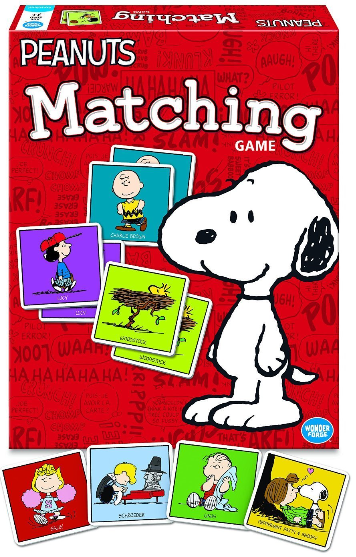 |
| Peanuts Matching Game - A simple memory game with Charlie Brown images. |
I have found that because of the yearly holiday TV specials, kids today still enjoy Snoopy, Charlie Brown, Lucy, Linus, and the rest of the gang. With that said, I was tickled to stumble onto this Peanuts Matching Game this week. I'm sure I had a smile on my face as I made myself comfortable in my favorite chair and opened the box. I was immediately charmed by the wide variety of pictures, both single characters and simple scenes. With my current caseload I have not used a Memory game in awhile, but I will be evaluating the kids that this would be appropriate for and using it in the next couple of weeks. I hope they enjoy playing as much as I do. In case you are not familiar with memory (matching) games, here are the rules:
1. Turn all the cards face down on the playing surface (table, floor, etc.)
2. Each player takes turns turning over two cards. If the pictures match, the player takes the cards and plays again. If they don't match, the cards are flipped back over and the next person plays.
That's it. When all the cards have been matched up, each person counts his sets. The one with the most sets wins. With not a lot of complicated rules, Memory games are a good visual memory workout for "kids" of all ages. Another neat thing about Memory games is that each time you play it's a new game, as the cards will all be in different positions. When some kids play they tend to pick up the card, look at it, and place it somewhere else when they return it to the table. That game could take a LONG time to finish. Always put the card back in the same spot so that the players have a chance to memorize its location.
To read more about why memory games are so popular, read my post Memory Games. Why are They so Popular? This post also has links to the other memory games I have blogged about.
Try this:
- Reduce the amount of sets you play with if 72 cards is too challenging. Add back in one set at a time to increase the challenge over time.
- Turn all the cards face-up and find the sets for a simpler matching game.
- Place one card from each set face up on the table. Describe a scene and ask the individual to scan the cards and find that one. Use colors, gender, activities in the scenes if the individual is not familiar with Peanuts and does not know the character names.
- Place one card from each set face up on the table. Place the remaining cards face down on the table. Choose one face down card, look at it, and see who can find its match first.
- Write simple descriptions on strips of paper of some of your favorite images, such as Snoopy kissing Peppermint Patty or Schroeder playing the piano, or Lucy, Sally and Snoopy skating. Lay all cards face up on the table. Choose a strip of paper and read the description. See who can be first to find the set.
- Ask the child to flip the card in its place, not attempt to pull it to the side of the table to pick up.
- Empty the box on the table. Ask the individual to place the cards all face down in preparation for play. Request that he pick up each card as it lays and turn it in-hand to the correct side and orientation for placement.
- Put the cards away at the end by picking up one card, stacking it on top of another and picking up both cards, stack those on top of another and pick up the three cards, etc. Keep going and see how many your hand can hold without dropping.
- Turn one card from each set face up on the table. Give directions such as 1) point to the cards that have Snoopy on them, 2) count the cards that have green backgrounds, 3) pick up the cards that show things you could do in the winter.
- Work
on visual memory, visual discrimination, spatial relations, manual
dexterity, figure ground, crossing midline, play and leisure activity
exploration and participation, socialization skills, process skills,
executive functioning skills
In the box: 36 sets (72 cards)



No comments:
Post a Comment
Thank you for taking the time to comment.